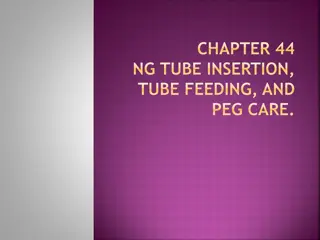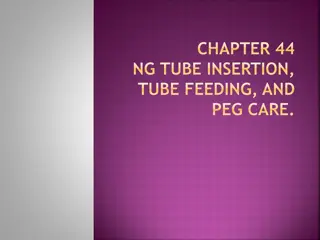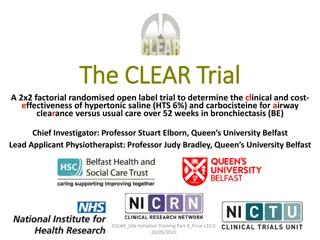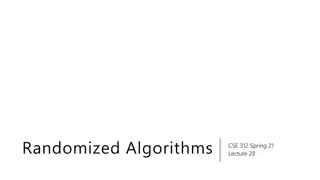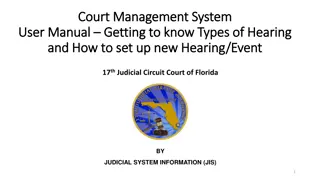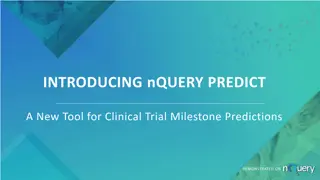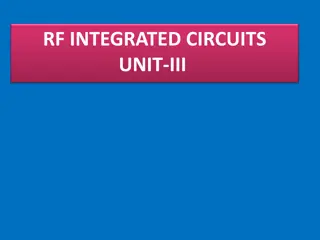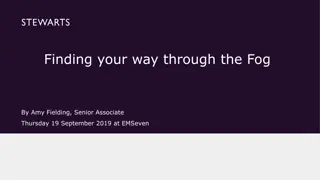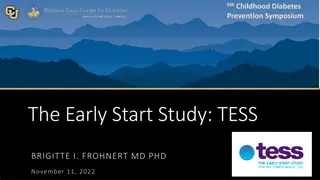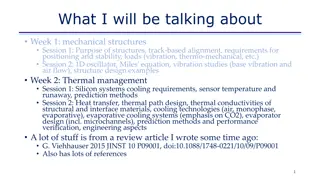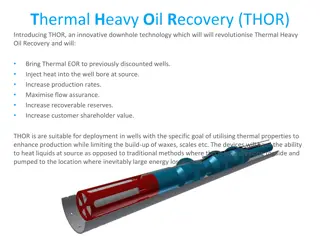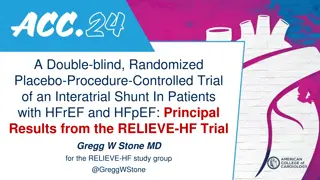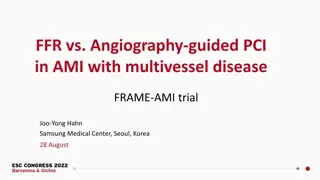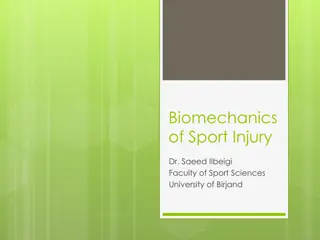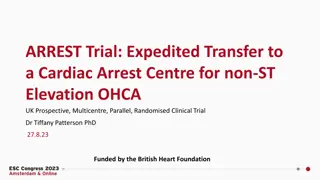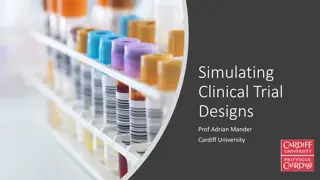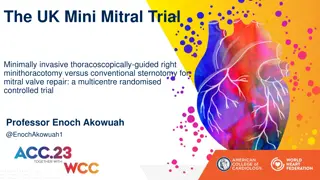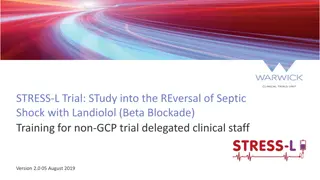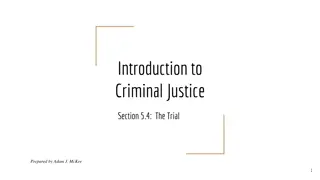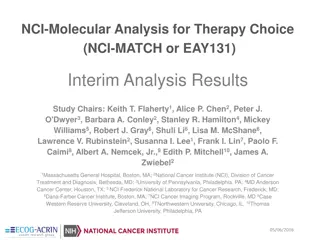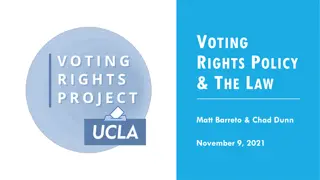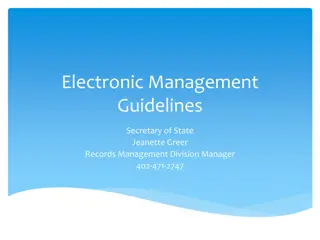Electronic Case Report Form (eCRF) for Randomized Trial of Enteral Glutamine to Minimize Thermal Injury
Development of case report form worksheets for data collection in a randomized trial focusing on enteral glutamine use to minimize thermal injury. The document provides detailed instructions for research coordinators on data recording from medical charts to be entered into the electronic data capture system. Specific guidelines are outlined for patient randomization numbers, date and time formats, study days definition, and data collection frequency across various sections of the trial. Contact information for the project leader is provided for any inquiries.
Download Presentation

Please find below an Image/Link to download the presentation.
The content on the website is provided AS IS for your information and personal use only. It may not be sold, licensed, or shared on other websites without obtaining consent from the author. Download presentation by click this link. If you encounter any issues during the download, it is possible that the publisher has removed the file from their server.
E N D
Presentation Transcript
Randomization Number A Randomized Trial of Enteral Glutamine to Minimize Thermal Injury Clinical trials.gov ID #NCT00985205 Electronic Case Report Form (eCRF) Worksheets and Instructions Please direct questions to: Maureen Dansereau Project Leader Tel: 613-549-6666 ext. 6686 Email: danserem@kgh.kari.net 17 March 2016 1
Randomization Number Table of Contents Page # General Instructions 3 Central Randomization System (CRS) web address 4 Screening Inclusion 5 Screening Exclusion 7 Pre-randomization / Randomization 9 REDCap (Electronic Data Capture System) web address 11 Baseline 12 Organ Dysfunction 15 Invasive Mechanical Ventilation/ Renal Replacement Therapy 17 Burn Grafting Assessment 19 Study Intervention 21 Daily Monitoring 23 Laboratory 25 Nutrition Assessment/Timing 27 Daily Nutrition 29 Burn Related Operative Procedures 33 Concomitant Medications 35 Microbiology 37 Protocol Violation 39 Hospitalization Overview 41 Month 6 Survival Assessment 43 Month 6 Follow-up Assessments: Contact Log 45 Month 6 Follow-up Questionnaires 47 SF-36 48-52 Katz Index of Independence in Activities in Daily Living (ADL) 53 Lawton Instrumental Activities of Daily Living (IADL) 54 Employment Status Questionnaire 55-57 Investigator Confirmation 60 Appendix 1: Lund-Browder Diagram 61 2
General Instructions The following case report form worksheets have been developed to assist the research coordinator at the participating site with data collection. The Research Coordinator (RC) may choose to record the data from the patient s medical chart (source document) on these forms before entering the data in to the electronic data capture system i.e. REDCAP . The RC may choose to enter data into REDCap her/his own worksheets. Whichever method is used, the instructions on each page that detail how and when the data is to be collected applies. directly from the medical chart or use Note: The appearance of these worksheets and the order in which they appear may vary slightly from REDCap . 1. To help you keep track, we recommend documenting the patient randomization number on each worksheet. 2. In this document, Acute Care Unit (ACU) is used to refer to both Intensive Care Units and Burn Units. 3. Date format will be year-month-day, entered as yyyy-mm-dd. For example, September 8th 2015 would be entered as: 2015-09-08 . 4. All times should be recorded using the 24 hour clock. Midnight is to be entered as 00:00 hrs. Unlike military time, the colon is required between the hour and the minutes. 5. Anywhere that 'Other (specify)' is selected, there must be an entry in REDCap describing what 'other' means. (in the space provided) 6. Study days are defined as follows and data must be collected according to study days: Study Day 1 = ACU admit date (not randomization) and time until 23:59 the same day. Study Day 2 = the subsequent day starting at 00:00 to 23:59 that day Example: A patient is admitted to the ACU on Sept 8th, 2015 at 4:00 PM (16:00). The study days would be: Study Day 1 = 2015-09-08 from 16:00 to 2015-09-08 at 23:59 Study Day 2 = 2015-09-09 from 00:00 to 2015-09-09 at 23:59 8. The duration of data collection and frequency will vary by form and is outlined as follows: To be collected once: Baseline, Organ Dysfunction, Initial Burn Assessment, Nutrition Assessment/Timing, Final Burn Assessment, Hospitalization Overview, 6 Month Follow-up to include Survival, SF-36, ADL, IADL, and Employment Status questionnaires. To be collected from Study Day 1 (ACU admission) until 10 days post last successful grafting, or until ACU discharge, or 3 months from ACU admission, whichever comes first: Daily: Daily Nutrition, Concomitant Medications, Microbiology (Gram-negative bacteremias). Daily from Study Day 1 through Study Day 14 and then weekly: Laboratory To be collected from randomization until 7 days post last successful grafting, or until ACU discharge, or 3 months from ACU admission, whichever comes first: Daily: Daily Monitoring (dose of study intervention received) To be collected upon each occurrence: Burn Related Operative Procedures, Mechanical Ventilation, Renal Replacement Therapy, Protocol Violations, Serious Adverse events To be collected Weekly/other specified intervals: Nutrition Assessment/timing, Refer to specific instructions for each worksheet. 9. There may be occasions when data is unavailable, not applicable or not known. The measurement may not have been taken, the test not done, or the data may be missing from the source document. Example: T-Bilirubin was not done on a particular study day. If the data is 'Not Available'for any reason, indicate by checking the N/A box on the worksheet and in REDCap . 3
Central Randomization System (CRS) The following pages (7 - 12 inclusive) refer to the data to be entered into the Central Randomization System (CRS). Access the CRS at the following web address: https://ceru.hpcvl.queensu.ca/CRS/ Enter all patients who meet the Inclusion Criteria. 4
Randomization Number Screening - Inclusion Instructions Only patients who meet the inclusion criteria should be entered into the Central Randomization System (CRS). Eligibility must be confirmed by the Site Investigator/or sub-Investigator before randomization can occur. The presence of deep 2nd and/or 3rd degree burns requiring grafting is an assessment that is made by the surgeon/physician and must be confirmed by the SI or sub-I. Inclusion Criteria 1. Presence of 2nd and/or 3rd degree burns requiring skin grafting The following burn injuries fulfill this criteria Thermal burn injuries: Scald Fire (includes both Flame and Flash) Radiation Chemical Unknown Other, Specify__________________ The following burn injuries do NOT fulfill this criteria Do NOT include injuries from any of the following: High voltage electrical contact (see exclusion #7.) Frost bite Stevens-Johnson Syndrome (SJS) Toxic Epidermal Necrolysis (TEN) This assessment is to be made by the surgeon/physician and must be confirmed by the SI or sub-I based on her/his clinical judgment. Refer to Appendix 1. Check only one box to indicate which of the 3 criteria is met. 2. the following 3 criteria: Patient meets one of Eligibility Requirements: a) Patients 18 - 59 years of age with TBSA > 20%. b) Patients 18 - 59 years of age with TBSA> 15% and with inhalation injury*. c) Patients > 60 years of age with TBSA> 10% (with or without inhalation injury). *Diagnosis of inhalation injury requires both of the following 2 criteria: 1. History of exposure to products of combustion 2. Bronchoscopy confirming one of the following: a) Carbonaceous material b) Edema or ulceration When including a patient age 18 59 years with a 15% 19.9 % TBSA with inhalation injury, there must be brochoscopic confirmation of inhalation injury. Consent must be obtained within 72 hours of admission to the ACU. Refer to exclusion criteria for more details. 5
Randomization Number Screening Inclusion Inclusion Criteria Yes No 1. Presence of Deep 2nd and/or Deep 3rd degree burns requiring grafting 2. Patient meets one of the following 3 criteria: a. Patients 18 - 59 years of age with TBSA 20% b. Patients 18 - 59 years of age with TBSA 15% WITH inhalation injury b. c. Patients > 60 years of age TBSA > 10% (with or without inhalation injury) c. a. 6
Randomization Number Screening - Exclusion Instructions Record all exclusion criteria that the patient meets. If any one of the twelve criteria below are met, then the patient is NOT ELIGIBLE. 1. >72 hours from admission to Acute Care Unit to time of consent This refers to admission to your ACU. If a patient is transferred from another facility, the clock starts from the time of admission to your unit. An exception would be a patient who has been at another facility for an extended period of time, post burn, prior to admission to your unit. 2. Patients younger than 18 years of age There is no upper age limit for enrollment in this study. 3. Renal Dysfunction: In patients without known renal disease, renal dysfunction defined as a serum creatinine >171 mol/L or >1.93 mg/dL or a urine output of less than 500 mL/last 24 hours (or 80 mL/last 4 hours if a 24 hour period of observation is not available). In patients with acute or chronic renal failure (pre-dialysis), an absolute increase of >80 mol/L or >0.9 mg/dL from baseline or pre-admission creatinine or a urine output of <500 mL/last 24 hours (or 80 mL/last 4 hours) will be required. Patients with chronic renal failure on dialysis will be excluded. 4. Liver cirrhosis Child-Pugh Class C liver disease (see chart below) Criteria Points assigned 2 2 - 3 mg/dL or 34 51 mol/L 2.8 3.5 g/dL 28 35 g/L 4 6 seconds 1.7 2.3 Slight 1 < 2mg/dL or < 34 mol/L > 3.5 g/dL or > 35 g/L < 4 seconds < 1.7 Absent 3 > 3 mg/dL or > 51 mol/L < 2.8 g/dL or < 28 g/L > 6 seconds > 2.3 Moderate The Child-Pugh Class C score is obtained by adding the points for all 5 criteria in this table. Total Bilirubin SI units Serum Albumin SI units Prothrombin time or INR Ascites* Any patient having a score of 10 15 falls into Group C (severe hepatic impairment), which would be considered exclusion for this study. None Moderate Severe Encephalopathy * Refer to ultrasound results. If ascites has been drained in the past, it should be considered Moderate. 5. Pregnant or lactating Urine/blood tests for pregnancy will be done on all females of childbearing age by each site as part of standard of ACU practice. 6. Contra-indication for Enteral Nutrition: intestinal occlusion or perforation, abdominal injury. Being NPO is not a contraindication for Enteral Nutrition. 7. Patient with injuries from high voltage electrical contact 8. Patients who are moribund: Not expected to survive the next 72 hours. An isolated DNR does not fulfill this criteria. 9. Patients with extreme body size: BMI <18 or >50 kg/m2 10. Enrollment in another industry sponsored ACU intervention study Co-enrollment in academic studies will be considered on a case by case basis. 11. Received glutamine supplement for > 24 hours prior to randomization This refers to continuous administration of glutamine for 24 hours prior to randomization. 12.Known allergy to maltodextrin, cornstarch, corn, corn products or glutamine. If the patient meets all inclusion criteria and does NOT meet any of the above exclusion criteria, patient is eligible for randomization and you may proceed to the Pre-randomization/Randomization form. 7
Randomization Number Screening Exclusion Exclusion Criteria 1. >72 hours from admission to (your) Acute Care Unit to time of consent Yes No 2. Patients younger than 18 years of age Yes No 3. Renal Dysfunction - In patients without known renal disease, renal dysfunction defined as a serum creatinine >171 mol/L or >1.93 mg/dL or a urine output of less than 500 mL/last 24 hours (or 80 mL/last 4 hours if a 24 hour period of observation is not available). - In patients with acute or chronic renal failure (pre-dialysis), an absolute increase of >80 mol/L or >0.9 mg/dL from baseline or pre-admission creatinine or a urine output of <500 mL/last 24 hours (or 80 mL/last 4 hours) will be required. - Patients with chronic renal failure on dialysis will be excluded. Yes No 4. Liver cirrhosis Child-Pugh Class C liver disease Yes No 5. Pregnant or lactating (urine/blood tests for pregnancy will be done on all women of childbearing age by each site as part of standard ACU practice). Yes No 6. Contra-indication for EN (intestinal occlusion or perforation, intra- abdominal injury). Yes No 7. Patients with injuries from high voltage electrical contact Yes No 8. Patient who is moribund (not expected to survive the next 72 hours) Yes No 9. Patients with extreme body sizes: BMI < 18 or > 50 kg/m2 Yes No 10. Enrollment in another industry sponsored ACU intervention study (co- enrollment in academic studies will be considered on a case by case basis) Yes No 11. Received glutamine supplement (continuously) for >24 hours prior to randomization Yes No 12. Known allergy to maltodextrin, cornstarch, corn, corn products or glutamine Yes No 8
Randomization Number Pre Randomization / Randomization Instructions If inclusion criteria are present AND no exclusion criteria are met the patient is considered eligible for randomization into the study. General Instructions Complete all fields as indicated. Confirm eligibility of the patient with the site investigator or sub-investigator. Patient Eligibility Confirmed by MD Consent Enter the name of the physician who confirmed patient eligibility. This individual should be listed on the Site Delegation of Authority Log. Confirm if the SDM or patient was approached for consent. If the SDM/patient was not approached for consent, indicate the reason why Reason consent not obtained Reason Description Next of kin or substitute decision maker not available Missed the patient The SDM or legally acceptable representative was not available for consent discussion within the required time frame. The patient was not identified by the site coordinator in time to approach for consent. Example: the patient was admitted over a long weekend. The SDM was not approached because of language barriers. A certified translator was not present. The SDM was not approached due to emotional stress or complicated family dynamics. Language Barriers Family dynamics Recommendation of the clinical team CRS Unavailable Pharmacy Unavailable Other (Please specify) Clinical team does not recommend putting this patient on the study. The Central Randomization System (CRS) is unavailable. The pharmacy not available to prepare the investigational product. Specify the reason(s) for not obtaining consent that is not listed above. Example: patient received glutamine for >24 hrs before randomization If approached for consent, was consent obtained from the SDM/patient? If No, record the most important reason consent was not obtained. o 'Too Overwhelmed', 'Not interested', 'Did not respond (timed out)' or Other' and specify the reason. If Yes, record the consent date/time and the patients height and weight Use patient s pre-burn dry weight to avoid fluctuations due to large fluid shifts. Indicate how the weight and height were each obtained: o Measured (obtained by a weighing scale) o Estimated (obtained verbally from a healthcare professional or family) o Record the height in cm and the weight in kg (to the nearest decimal point). Consent Date and Time Pre Burn Weight and Height Log onto the Central Randomization System (CRS) to obtain the date and time of randomization. Randomization Date and Time 9
Randomization Number Pre Randomization Yes No Did you confirm eligibility of the patient with the site investigator, or sub-investigator? Please indicate the name of the physician who confirmed patient eligibility Was SDM/patient approached for consent? If No , please indicate why SDM/patient was not approached for consent (Select one) Yes No Next of kin or SDM not available Missed patient Language barriers Family dynamics Recommendation of the clinical team CRS unavailable Pharmacy unavailable Other (Please specify) Yes No Too Overwhelmed Not interested Did not respond (timed out) Other (Please specify) If Yes , was consent obtained from the SDM/patient? If No , choose the most important reason why consent was not obtained If Yes , record the following: Consent Date (yyyy-mm-dd) Consent time (hh:mm) (24 hour clock) Height cm or inches Measured Estimated Unknown Measured Weight kg or lbs Estimated Unknown Randomization Date and time of randomization 2 Y 0 : Y Y Y M M D D H H M M (24 hour clock) Pharmacy must be notified as soon as patient is randomized 10
Data Collection REDCap (Electronic Data Capture System) REENERGIZE - Definitive Access REDCap at the following web address: https://ceru.hpcvl.queensu.ca/EDC/redcap/ 11
Randomization Number Baseline Instructions General Instructions Age Complete all of the information by selecting the appropriate box and entering the required data for each field as indicated. These data are to be collected once, at baseline. Enter the age of the patient in years at the time of screening (patients must be > 18 years of age to be eligible to participate in The RE-ENERGIZE Study). Select the appropriate box (female or male). Choose the appropriate patient ethnicity from the following list: Asian or Pacific Islander East Indian Black or African American Hispanic Sex Ethnic Group Native White or Caucasian Other (please specify) APACHE II score Go to the following website http://www.sfar.org/scores2/apache22.php to calculate the APACHE II score. Record the calculated score. Use variables within the first 24 hrs of this ACU admission. If variables are not available from the first 24 hrs, go outside the 24 hr window and use data closest to ACU admission. NOTE: ensure the units that you are using for serum sodium, potassium and white blood count are correct. Select all comorbidities on the list provided. Only those comorbidities found on the taxonomy listing should be recorded. If no comorbidities are present, select No comorbidities Comorbidities History of Alcohol abuse: We would like to monitor the number of subjects that are enrolled in the study who have a history of alcohol abuse. As such, please note that we have added alcohol abuse to the Comorbidities list under the miscellaneous category. Therefore if a subject has a documented history of alcohol abuse in the medical chart, it should be recorded in the CRF. Tobacco use Indicate whether the patient is a current smoker or uses tobacco, Yes or No. If you are not able to obtain this information, select 'Not Available'. Hospital admit Enter the date and time of hospitalization. This is the time of initial presentation to your emergency department or hospital ward, whichever is the earliest. If the patient is admitted directly to the ACU, this date and time becomes the Hospital admit date and time. If the admit time is not available, enter the time of the first documentation. Enter the date and time of ACU admission. If the patient is admitted directly to the ACU, this date and time is the same as the Hospital admit date and time. If the admit time is not available, enter the time of the first chart documentation. Is the patient co-enrolled in another academic ACU study? If Yes, then enter the name(s) of the study(ies). Enter the date and time the burn injury occurred. If the time of the burn is not available , select 'No time available'. ACU admit Co-enrollment Date and time of burn Type of burn Select the type of burn that best describes the nature of the thermal burn injury from the list below (select only one). Frostbite is NOT considered a type of burn for this study. Scald Fire (Includes both flame and flash burns) Chemical Radiation Unknown Other (please specify) ______________ Record the total burn size as percent Total Body Surface Area (%TBSA). This assessment is to be made by the attending surgeon/physician based on her/his clinical judgment and confrimed by the SI/sub-I. (Refer to Appendix 1). Record TBSA in the nearest whole number rounding up from 0.5 and down from 0.4; i.e. if 26.5% is reported, record as 27% and if 26.4% is reported, record as 26%. Do NOT Include Electrical Burns Frost Bite Steven-Johnson Syndrome (SJS) Toxic Epidermal Necrolysis (TEN) Burn Size expressed as % TBSA Presence of Inhalation Injury Indicate if the patient has an inhalation injury by selecting 'Yes' or 'No' Smoke inhalation injury is defined as: restricted to injury below the glottis caused by products of combustion. Diagnosis of inhalation injury requires both of the following: 1) history of exposure to products of combustion 2) bronchoscopy revealing one of the following below the glottis Evidence of carbonaceous material Signs of edema or ulceration Did the patient receive high dose Vitamin C as part of her/his resuscitation protocol (approximated as 66mg/kg/hr)? Y/N 12 Vitamin C
Randomization Number Baseline Age (years) years Sex Female Male Ethnic group Asian or Pacific Islander Black or African American East Indian Hispanic Native White or Caucasian Other (Please specify): APACHE II Comorbidities (If Yes , select from the list provided) Yes No Tobacco Use Yes No Not Available Hospital Admit Date and Time (hh:mm) (24 hour clock) (yyyy-mm-dd) ACU Admit Date and Time (hh:mm) (24 hour clock) (yyyy-mm-dd) Is this patient co-enrolled in another academic ACU study? Yes No If Yes , Please specify: Burn Injury Date and Time (hh:mm) (24 hour clock) No Time Available Unknown Other (Please specify): (yyyy-mm-dd) Type of Burn (Select only one) Scald Fire (includes flame and flash) Chemical Radiation Burn Size expressed as % Total Body Surface Area (TBSA) %TBSA Yes No Does the patient have an inhalation injury? (Must be confirmed by bronchoscopy) Did the patient receive high dose Vitamin C as part of her/his resuscitation protocol (approximately 66mg/kg/hr)? Yes No 13
Randomization Number Comorbidities Check all the comorbidities that apply. If the patient has no comorbidities, check 'No Comorbidities'. No Cormorbidities Myocardial 1. Angina 2. Arrhythmia 3. Valvular 4. Myocardial infarction 5. Congestive heart failure (or heart disease) Gastrointestinal 18. Mild liver disease 19. Moderate or severe liver disease 20. GI Bleeding 21. Inflammatory bowel 22. Peptic ulcer disease 23. Gastrointestinal Disease (hernia, reflux) Vascular 6. Hypertension 7. Peripheral vascular disease or claudication 8. Cerebrovascular disease (Stroke orTIA) Cancer/immune 24. Any Tumor 25. Lymphoma 26. Leukemia 27. AIDS 28. Metastatic solid tumor Pulmonary 9. Chronic obstructive pulmonary disease (COPD, emphysema) 10. Asthma Psychological 29. Anxiety or Panic Disorders 30. Depression Neurologic 11. Dementia 12. Hemiplegia (paraplegia) 13. Neurologic illnesses (such as Multiple sclerosis or Parkinsons) Muskoskeletal 31. Arthritis (Rheumatoid or Osteoarthritis) 32. Degenerative Disc disease (back disease, spinal stenosis or severe chronic back pain) 33. Osteoporosis 34. Connective Tissue disease Endocrine 14. Diabetes Type I or II 15. Diabetes with end organ damage 16. Obesity and/or BMI > 30 (weight in kg/(ht in meters)2 Miscellaneous 35. Visual Impairment (cataracts, glaucoma, macular degeneration 36. Hearing Impairment (very hard of hearing even with hearing aids) 37. Alcohol Abuse Renal 17. Moderate or severe renal disease 14
Randomization Number Organ Dysfunction Instructions These data are collected once at baseline for calculation of modified SOFA score. General Instructions Vasopressors Indicate whether the patient received vasopressors or not be selecting Yes or No . If Yes , select the highest dose received from the 3 groupings below: Dopamine 5 g/kg/min or Dobutamine (any dose) Dopamine 6 - 15 g/kg/min or Epinephrine 0.1 g/kg/min or Norepinephrine 0.1 g/kg/min Dopamine > 15 g/kg/min or Epinephrine > 0.1 g/kg/min or Norepinephrine > 0.1 g/kg/min If No , enter MAP (mean-arterial pressure), see below. Indicate the lowest MAP observed during the study day by selecting from the options below : MAP (mean arterial pressure) < 70 mmHg > 70 mmHg If the MAP is not available you can calculate it using the formula: MAP = 1/3 lowest systolic BP + 2/3 corresponding diastolic BP Or use the tool on the website: http://www.mdcalc.com/mean-arterial-pressure-map/ Indicate the volume range of urine output for the study day by selecting from the list below: Urine output (mL) < 200 mL/day < 500 mL/day >= 500 mL/day Not Available 15
Randomization Number Organ Dysfunction (Baseline) Date (yyyy-mm-dd) Vasopressors Did the patient receive vasopressors? Yes No If Yes , select the highest dose received during the study day. Dopamine 5 g/kg/min or Dobutamine (any dose) Dopamine 6 - 15 g/kg/min or Epinephrine 0.1 g/kg/min or Norepinephrine 0.1 g/kg/min Dopamine > 15 g/kg/min or Epinephrine > 0.1 g/kg/min or Norepinephrine > 0.1 g/kg/min If No , enter MAP below. MAP (lowest) < 70 mmHg > 70 mmHg Urine output < 200 mL/day < 500 mL/day >= 500 mL/day Not Available 16
Randomization Number Invasive Mechanical Ventilation / Renal Replacement Therapy (Dialysis) Instructions General Instructions These data are collected to determine the duration of invasive mechanical ventilation and need for renal replacement therapy (dialysis). Duration of Data Collection Invasive Mechanical Ventilation #1 These data are to be collected at start and stop of invasive mechanical ventilation and renal replacement therapy (dialysis). Indicate whether the patient received invasive mechanical ventilation during this ACU stay by selecting Yes or No . If Yes , enter the actual start date and time of invasive mechanical ventilation, even if this occurs at an external institution or in the field before admission to your unit. This may not be the same time that the patient was intubated, but should be the time invasive mechanical ventilation was started. Indicate by selecting if start time is Not available . Start Do not record episodes of temporary ventilation (defined as <48 hrs i.e. needed for operating procedures, etc). Stop After the patient has been successfully breathing without mechanical ventilation for > 48 hours, record the start of the 48 hour period as the stop date and time for this episode of invasive mechanical ventilation. Patients will be considered breathing without mechanical ventilation in any of these instances: extubated and on face mask (nasal prong) intubated or breathing through a t-tube tracheostomy mask breathing. continuous positive airway pressure (CPAP) <=5cmH2O without pressure support or intermittent mandatory ventilation assistance. If patient is transferred out of the ACU to another institution and is still receiving mechanical ventilation, record the transfer date and time as the mechanical ventilation discontinuation date and time. If the patient expired while mechanically ventilated, select 'Same as death date & time'. If the patient is still mechanically ventilated 3 months after ACU admission, then select 'Still vented at Day 90'. If the patient is restarted on Mechanical ventilation > 48 hours after discontinuation of the last episode, select Yes to the question Was mechanical ventilation re-instituted > 48 hours from the last mechanical ventilation stop date/time? to access the data entry fields for another episode. Record the date and time invasive mechanical ventilation was restarted. Mechanical Ventilation #2 Start Stop Record the date and time the invasive mechanical ventilation episodewas discontinued (see episode #1 above for further instructions). Follow the instructions as listed for Mechanical Ventilation start # 2 and stop # 2 for the third, fourth, and fifth episodes of mechanical ventilation, if applicable. Mechanical Ventilation #3 - #5 Renal Replacement Therapy (Dialysis) Indicate whether the patient received RRT during this ACU stay by selecting Yes or No . If Yes , respond to the question The first time renal replacement therapy (dialysis) was started, was it due to acute renal failure? by selecting Yes or No . Was first RRT start due to Acute Renal Failure? RRT (Dialysis) If Yes , record the date RRT (dialysis) started Start RRT (Dialysis) Select one of the following: Same as death date & time At 3 months, still on renal replacement therapy (dialysis) in hospital Continued past hospital discharge Actual stop date (Record the date dialysis was permanently discontinued. This may occur on the ward. ) Stop 17
Randomization Number Invasive Mechanical Ventilation Date Time (yyyy-mm-dd) (24 hour clock) Mechanical Ventilation # 1 Yes (Record start date & time) Did the patient ever receive invasive mechanical ventilation? Not available If start time is not available No Record stop date & time Mechanical ventilation stop: Same as death date & time Still vented at Day 90 Mechanical Ventilation # 2 Yes (Record start date & time) Was mechanical ventilation re-instituted 48 hours from the last ventilation discontinuation date/time? Mechanical ventilation stop: No Record stop date & time Same as death date & time Still vented at Day 90 Mechanical Ventilation # 3, #4, #5 Yes (Record start date & time) Was mechanical ventilation re-instituted 48 hours from the last ventilation discontinuation date/time? Mechanical ventilation stop: No Record stop date & time Same as death date & time Still vented at Day 90 Renal Replacement Therapy (Dialysis) Yes No Yes (Continue to the next row) No (Do not complete below) Did the patient receive renal replacement therapy (dialysis) during this ACU stay? The first time renal replacement therapy (dialysis) was started, was it due to acute renal failure? -Start Date Date -Stop Date Same as death date & time At 3 months, still on renal replacement therapy (dialysis) in hospital Continued past hospital discharge Actual stop date Date 18
Randomization Number Burn Grafting Assessment Instructions An assessment of the burn injury must be completed by the attending surgeon/physician twice during the study; once at the beginning of the study and once at the end of the study duration, defined as 10 days post last successful grafting, or ACU discharge, or 3 months from ACU admission, whichever occurs first. General Instructions Record the date the initial grafting assessment was completed by the attending surgeon/delegate. The surgeon/physician must assess the deep 2nd and/or 3rd degree burn using the Lund and Browder chart (see Appendix 1): to determine the percent Total Body Surface Area (%TBSA) expected to require grafting. This assessment must be confirmed by the SI or sub-I. Reminder: Deep 2nd and/or 3rd degree burn requiring grafting is an inclusion criteria. This should not be zero. Indicate whether the last successful graft was achieved by selecting Yes or No Date of initial assessment Initial Grafting Assessment Last Successful Graft If Yes , enter the date of the last successful graft in the format yyyy-mm-dd. If No , select the reason the last successful graft was never achieved: Death Withdrew Consent (including consent for data collection) Withdrew Life Sustaining Therapies Discharged without receiving a graft Receiving grafts after ACU discharge (< 3 mo.) Still receiving grafts in ACU at 3 months Other, specify: __________________________ Record the date of final/last grafting assessment was completed by the attending surgeon/physician. The assessment must be confirmed by the SI/sub-I and should be done at the end of the study duration, defined as 10 days post last successful graft, or ACU discharge, or 3 months after ACU admission, whichever occurs first. Date of final/last assessment A Final Grafting assessment must be completed on all patients, even if the patient is still receiving grafts or expected to receive additional grafts at the time of the assessment. Exception: Do not record final assessment if Death or Withdrew Consent selected above. Final/Last Grafting Assessment Area that required grafting At the end of the study period, using the Lund and Browder chart, the surgeon/physician must assess the %TBSA that required grafting during the study period. This assessment must be confirmed by the SI or sub-I. If the patient is still receiving grafts at the time of the assessment, indicate the %TBSA that has required grafting to date. Note: Be sure to record the final assessment in percentage of total body surface area. This should not be 100% unless the patient s entire body received grafting. 19
Randomization Number Burn Grafting Assessment INITIAL GRAFTING ASSESSMENT Date of initial assessment (yyyy-mm-dd) Deep partial/full thickness burn (expected to require grafting) (Deep 2nd and/or 3rd degree burn requiring grafting is an inclusion criteria. This should not be zero.) % TBSA LAST SUCCESSFUL GRAFT Was the last successful graft achieved? If Yes, Date of last successful graft If No, reason last successful graft never achieved: Yes No (yyyy-mm-dd) Death Withdrew Consent (including consent for data collection) Withdrew Life Sustaining Therapies Discharged without receiving a graft Receiving grafts after ACU discharge (< 3 mo.) Still receiving grafts in ACU at 3 months Other, specify: ____________ ________________________ If death or withdrew consent is indicated, do not record the Final Assessment. FINAL GRAFTING ASSESSMENT to be done at or after 10 days post last successful grafting, or ACU discharge, or 3 months after admission to the ACU Date of final assessment (yyyy-mm-dd) Area that required grafting (actual or total at the time of assessment ) % TBSA 20
Randomization Number Study Intervention Study intervention is to be started within 2 hours of randomization. General Instructions Duration of Data Collection These data are to be collected when study supplements are first started and when study supplements are finally stopped. In addition, any prescription changes will be recorded on this form. Enter the date and time study supplements were first started in the format yyyy-mm-dd and hh:mm Study Intervention Start Date and time If the study intervention is started more than 2 hours after randomization, select Yes and choose the reason from the list provided: Study Intervention started more than 2 hours from Randomization Pharmacy delay Patient NPO for surgery Awaiting tube placement and/or verification Patient not available (procedure) Nurse not available Other (specify): _______________________ If you select Other , you must provide and explanation in the space provided. Enter the date and time study supplements were finally stopped in the format yyyy-mm-dd and hh:mm The stop date should be at the end of the study period, i.e. 7 days after the last successful grafting operation or at discharge from ACU or 3 months from ACU admission, whichever occurs first. Study Intervention Stop Date and time Record the initial study intervention prescription in grams/day. Study Intervention Prescription Each packet contains 5 grams of study intervention. If 10 packets per day are to be given, enter 50 in the prescription box. If the study intervention prescription changes, record the new prescription and date/time the change occurred. NOTE: IP prescription should not change. EXCEPTION: If the patient has a change in body weight sufficient for the clinical team to alter dosage of clinical treatments, the study treatment should also be adjusted. 21
Randomization Number Study Intervention (hh:mm) Date and Time first dose of study intervention administered Was Study Intervention started > 2 hours from Randomization? If Yes, indicate the reason: (yyyy-mm-dd) (24 hour clock) Yes No Pharmacy delay Patient NPO for surgery Awaiting tube placement and/or verification Patient not available (procedure) Nurse not available Other (specify): ______________________________ (hh:mm) Date and Time the last dose of study intervention administered Initial Study Intervention Prescription (yyyy-mm-dd) (24 hour clock) grams/day Did the prescription change during the study? Yes No If Yes, record the new prescription and the date/time of the change grams/day (hh:mm) (yyyy-mm-dd) (24 hour clock) If the prescription changed again, record the new prescription and the date/time of the change grams/day (hh:mm) (yyyy-mm-dd) (24 hour clock) 22
Randomization Number Daily Monitoring These data are collected to determine the compliance to the prescribed dose of the study intervention and to identify any dose related Protocol Violations. General Information Study intervention is to be started within 2 hours of randomization. Given the material affect on the study, these data are to be collected daily as close to REAL TIME as possible and as follows: Study Intervention: from randomization to 7 days post last successful grafting operation, or until ACU discharge, or until 3 months from ACU admission, whichever comes first. Dose related Protocol Violations: for duration of study intervention administration. Duration of Data Collection At the top of each page record the number of grams per day of investigational product (IP) the patient is to receive. NOTE: This is to assist you in determining the daily percentage of IP received. This data is not captured in REDCap on the Daily Monitoring forms. Enter the date for which the data being collected. Prescribed # grams per day Date Select the number of times, from 0 to 10, the study intervention was given on this study day. The same number of entry fields will appear on the form in REDCap Select the # grams given, from 5 to 30, at each interval as documented in the medical chart. Each packet of IP contains 5 grams. If dose is recorded in the medical chart as # of packets administered, multiply # of packets by 5 and select the # of grams administered. Select the route by which the study intervention was administered at each interval, EN or PO. Add the number of grams given at each interval and record the total number of grams administered for the day (for calculating percentage), this data is not entered in REDCap Divide the total number of grams actually given by the number of grams prescribed per day (documented at the top of the page) to determine the percentage of study intervention received. Record the percentage in the space provided. A protocol violation with the delivery of the study intervention occurs when the patient receives < 80% of the total prescribed daily dosage over a 3 day average. Report a dose related protocol violation when both of the following are true: Dose received on the indicated day is < 80% prescribed Dose received over a 3 day average is < 80% prescribed # Times IP administered # Grams given for that day. Route Total grams received today Percentage of study intervention received Protocol Violation (IP dosing <80% over a 3 day average) . Example: Dose received Prescribed Dose: 35g/day 80% Prescribed: 28g Day 8: 30g Total dose received over 3 days = 80g 3 day average dose is 80 g/ 3 = 26.67g Report Day 7: Dose received is < 80% AND 3 day average is < 80 % Day 6: 30g Day 7: 20g Do Not report Day 6 or Day 8: 3 day average is <80% BUT Dose received is NOT <80% In the event that the patient does not receive at least 80% prescribed daily dosage over a 3 day average, a Protocol Violation Form must be completed within 24 hours of becoming aware. 23 Refer to the Protocol Violations section in these worksheets for detailed instructions.
Randomization Number Daily Monitoring Prescribed # _______ gm/day Page #:_____ Date: yyyy-mm-dd # times IP given today (circle one) 0 1 2 3 4 5 6 7 8 9 10 0 1 2 3 4 5 6 7 8 9 10 0 1 2 3 4 5 6 7 8 9 10 0 1 2 3 4 5 6 7 8 9 10 0 1 2 3 4 5 6 7 8 9 10 1) # grams given (circle one) Route 5 10 15 20 25 30 EN 5 10 15 20 25 30 EN 5 10 15 20 25 30 EN 5 10 15 20 25 30 EN 5 10 15 20 25 30 EN PO PO PO PO PO 2) # grams given (circle one) 5 10 15 20 25 30 5 10 15 20 25 30 5 10 15 20 25 30 5 10 15 20 25 30 5 10 15 20 25 30 EN 5 10 15 20 25 30 PO EN 5 10 15 20 25 30 PO EN 5 10 15 20 25 30 PO EN 5 10 15 20 25 30 PO EN 5 10 15 20 25 30 PO Route 3) # grams given (circle one) EN 5 10 15 20 25 30 PO EN 5 10 15 20 25 30 PO EN 5 10 15 20 25 30 PO EN 5 10 15 20 25 30 PO EN 5 10 15 20 25 30 PO Route 4) # grams given (circle one) EN 5 10 15 20 25 30 PO EN 5 10 15 20 25 30 PO EN 5 10 15 20 25 30 PO EN 5 10 15 20 25 30 PO EN 5 10 15 20 25 30 PO Route 5) # grams given (circle) EN PO EN PO EN PO EN PO EN PO Route 6) # grams given (circle one) 5 10 15 20 25 30 5 10 15 20 25 30 5 10 15 20 25 30 5 10 15 20 25 30 5 10 15 20 25 30 EN 5 10 15 20 25 30 PO EN 5 10 15 20 25 30 PO EN 5 10 15 20 25 30 PO EN 5 10 15 20 25 30 PO EN 5 10 15 20 25 30 PO Route 7) # grams given (circle one) EN PO EN PO EN PO EN PO EN PO Route 8) # grams given (circle one) 5 10 15 20 25 30 5 10 15 20 25 30 5 10 15 20 25 30 5 10 15 20 25 30 5 10 15 20 25 30 EN PO EN PO EN PO EN PO EN PO Route 9) # grams given (circle one) Route 10) # grams given (circle one) 5 10 15 20 25 30 EN 5 10 15 20 25 30 5 10 15 20 25 30 EN 5 10 15 20 25 30 5 10 15 20 25 30 EN 5 10 15 20 25 30 5 10 15 20 25 30 EN 5 10 15 20 25 30 5 10 15 20 25 30 EN 5 10 15 20 25 30 PO PO PO PO PO EN PO EN PO EN PO EN PO EN PO Route TOTAL # grams given today Percentage of prescribed given Protocol Violation % % % Yes No % % Yes No Yes No Yes No Yes No 24
Randomization Number Laboratory Instructions These data are to be collected as follows: Daily for 2 weeks: From admission to the ACU through study day 14 Weekly: From day 15 to 10 days post last successful graft, d/c from the ACU, or 3 mos. after admission, whichever comes first. o Collect weekly lab data from a single day during that study week defined as +/- 24 hours from study day 21, 28, 35, 42, 49, 56, 63, 70, 77, 84 and 90. o If there is no value available on the specified date, record the value from an adjacent day. If there is no value available for that study week, record N/A. Enter the dates corresponding to the calendar day. Record the highest serum creatinine observed on the study day. Duration of Data Collection Date Creatinine, serum (highest) T-bilirubin (highest) Urea (highest) PaO2/FiO2 (PF ratio) Record the highest serum total bilirubin observed on the study day. Record the highest serum urea observed on the study day. Record the lowest PaO2/FiO2 (PF ratio) observed on the study day. The PaO2 and FiO2 values should come from the same blood gas measurement. If no PF ratio record N/A Record the glucose closest to 8am observed on the study day 6 hrs (i.e. from 02:00 to 14:00 hrs). Record the highest blood ammonia level reported on the study day. Glucose closest to 08:00 Ammonia (highest) Albumin (highest) Lactate (highest) Record the highest serum albumin observed on the study day. Record the highest lactate level observed on the study day. If not available record n/a in the box. Record the lowest serum platelets observed on the study day. Record the highest white blood count observed on the study day. If there is only one value recorded for the 24 hr period then record the one value as both the highest and lowest. Record the lowest white blood count observed on the study day. If there is only one value recorded for the 24 hr period then record the one value as both the highest and lowest. For each requested result above, if there is no value available to record, indicate by entering 'N/A' in the space provided. Platelets (lowest) WBC (highest) WBC (lowest) 25
Randomization Number Laboratory Page #:_____ Date (yyyy-mm-dd) Creatinine, serum (highest) T-bilirubin (highest) Urea (highest) PaO2/FiO2 (lowest) Glucose closest to 08:00 am Ammonia (highest) Albumin (highest) Lactate (highest) Platelets (lowest) WBC (highest) WBC (lowest) 26
Randomization Number Nutrition Assessment/Timing Instructions These data are collected to determine how well the patient is being fed i.e the nutritional adequacy (% calories and protein received/prescribed) and the timing of initiation of nutrition. Contact your dietitian to obtain this information. These will need to be calculated by the dietitian at baseline (ACU admission or at the first dietitian assessment) and thereafter. General Instructions Prescribed Energy and Protein needs Prescribed energy needs are to be calculated by using Indirect Calorimetry, a predictive equation, or a simple weight-based formula but on average, should not lead to a prescription of less than 30 kcal/kg. Use pre-burn weight.For Obese patients, if your standard practice is to adjust weight for obesity, use the weight you would use. If not, use ideal body weight. Please ask your dietitian for more details. Prescribed Protein needs are to be calculated by using the following: If > 50% burns, use 1.5g/kg/day to 2.5g/kg/day If < 50% burns, use 1.2 g/kg/day to 2 gm/kg/day Use pre-burn weight.For Obese patients, if your standard practice is to adjust weight for obesity, use the weight you would use. If not, use ideal body weight. Please ask you dietitian for more details. If the prescribed energy or prescribed protein intake changes from week to week, record this in the appropriate row (Assessment #2, #3, etc) and record the date the prescription changed. If there are no changes in the prescription from baseline, place a check in the 'No change from baseline' box Note: Energy and protein requirements are independent of the formula prescribed. Do NOT change prescription to accommodate a formula change. If the patient did not receive enteral nutrition during this ACU admission, place a in the box titled 'Never received EN during this ACU admission'. Enteral Nutrition If the patient received Enteral nutrition, record the following: the start date and time of enteral nutrition. the stop date and time of enteral nutrition. This refers to the date enteral nutrition was permanently discontinued, not stopped for temporary interruptions. If enteral nutrition is continued beyond ACU discharge, record ACU discharge date and time as the date and time that enteral nutrition was stopped. If the patient is still receiving enteral nutrition in the ACU at 3 months, place a in the box titled 'Still on EN at 3 months in ACU'. If the patient did not receive parenteral nutrition during this ACU admission, place a in the box titled 'Never received PN during this ACU admission'.. Parenteral Nutrition If the patient received parenteral nutrition, record the following: the start date and time of parenteral nutrition. the stop date and time of parenteral nutrition. This refers to the date parenteral nutrition was permanently discontinued, not stopped for temporary interruptions. If parenteral nutrition is continued beyond ACU discharge, record ACU discharge date and time as the date and time that parenteral nutrition was stopped. If the patient is still receiving parenteral nutrition in the ACU at 3 months, place a in the box titled 'Still on PN at 3 months in ACU'. 27
Randomization Number Nutrition Assessment 2 Y 0 Date baseline prescription made Y Y Y M M D D Total Calories Prescribed: Total Protein Prescribed: kcal grams If the prescription changes for this patient, enter the date and new prescription below: Note: Energy and protein requirements are independent of the formula prescribed. Do NOT change prescription to accommodate a formula change. 2 Y 0 Date baseline prescription made Y Y Y M M D D Total Calories Prescribed: Total Protein Prescribed: kcal grams 2 Y 0 Date baseline prescription made Y Y Y M M D D Total Calories Prescribed: Total Protein Prescribed: kcal grams Nutrition Timing Enteral Nutrition Never received EN during this ACU admission Still on EN at 3 months in ACU Date and time enteral nutrition started 2 Y 0 : Y Y Y M M D D H H M M (24 hour clock) Date and time enteral nutrition stopped 2 Y 0 : Y Y Y M M D D H H M M (24 hour clock) Parenteral Nutrition Still on PN at 3 months in ACU Never received PN during this ACU admission Date and time parenteral nutrition started 2 Y 0 : Y Y Y M M D D H H M M (24 hour clock) Date and time parenteral nutrition stopped 2 Y 0 : Y Y Y M M D D H H M M (24 hour clock) 28
Randomization Number Daily Nutrition Instructions These data are collected to determine the adequacy of all types of nutrition (calories and protein received) General Instructions These data are to be collected daily from Study Day 1 (ACU admission) until 10 days post last successful grafting or ACU discharge or 3 months from ACU admission, whichever comes first. Enter the dates corresponding to the calendar day. For each day, indicate whether the patient received enteral nutrition (EN), Yes or No. Duration of Data Collection Date Enteral Nutrition Today? (If No ) If No to Enteral Nutrition, using the list below, indicate ALL the reason(s) the patient did not receive EN on the specified Study day by placing the number(s) in the box(es) provided: NPO for endotracheal extubation or intubation or other bedside procedure. If 'Other' is indicated, please also check the 'Other' box and specify the reason. NPO for operating procedure NPO for radiology procedure High NG drainage Increased abdominal girth, abdominal distension or pt. discomfort Vomiting or emesis Diarrhea No enteral access available / enteral access lost, displaced or malfunctioning Inotropes, vasopressor requirement Patient deemed too sick for enteral feeding On oral feeds Reason not known Other , please specify___________________ Enteral Nutrition Today? (If Yes ) If Yes to EN, using the EN Formula List, record the corresponding number or the name of the enteral formula received. You may record up to 3 different formulas used in a day. Record the first formula received in the spaces provided for 'Formula 1' and so on. If the formula given is not in the EN Formula List, select #82. Other Nutritional Formula and enter the name of the formula in the space provided. In the event that the patient receives more than 3 formulas in one day, select the 3 formulas that provide the largest volumes. Formula Record the total calories (kilocalories) and protein from all the EN formulas received in the study day. Do not include the calories from IV solutions, e.g. Dextrose (collected separately). Do not record the calories from propofol (volume to be entered separately). Do not include protein supplements as part of this total (collected separately). Record whether a protein supplement was received, 'Yes' or 'No'. If protein supplement was received, record the number or name based on the taxonomy provided in the following pages. If there is more than one protein supplement, record the name of each supplement. Record the total calories and protein received from protein supplements. For each day, indicate whether the patient received parenteral nutrition, Yes or No. Total kcals Total Protein Protein Supplements Parenteral Nutrition today? Total Kcals Total Protein IV Fluid containing Glucose today? If yes, record the total calories and grams of protein received from parenteral nutrition. Do not record calories from IV fluids (e.g. Dextrose) or Propofol volume here. For each day, indicate whether the patient received IV fluids containing glucose, Yes or No. If yes, record the total calories (kilocalories) received from IV fluids containing glucose. Indicate whether the patient received any oral intake today, Yes or No Oral feeding today? Propofol today? Total mL Indicate whether the patient received a continuous infusion of Propofol for 6hrs, Yes or No. If Yes , record the volume of propofol received in mL). 29 This is to be completed for each day regardless of whether the patient received enteral nutrition, parenteral nutrition or neither.
Randomization Number Daily Nutrition Page #:_____ Date (yyyy-mm-dd) Yes No Yes No Yes No Yes No Yes No EN Received If EN NOT received (Select all that apply) NPO for endotracheal extubation or intubation or other bedside procedure NPO for operating procedure NPO for radiology procedure High NG drainage Increased abdominal girth, abdominal distension or pt. discomfort Vomiting or emesis Diarrhea No enteral access available / enteral access lost, displaced or malfunctioning Inotropes, vasopressor requirement Patient deemed too sick for enteral feeding On oral feeds Reason not known Other (Please specify) If EN received (complete below) Formula 1 (Name or Number) Formula 2 (Name or Number) Formula 3 (Name or Number) Total Kilocalories from EN Total Protein from EN Yes No Yes No Yes No Yes No Yes No Protein Supplement Protein Supplement Name Total Calories from Protein Supplement Total Protein from Protein Supplement Yes No Yes No Yes No Yes No Yes No PN Received Total Calories from PN Total Protein from PN Yes No Yes No Yes No Yes No Yes No IV Fluids containing Glucose Total Calories from IV Fluids Yes No Yes No Yes No Yes No Yes No Yes No Yes No Yes No Yes No Yes No Oral Intake Propofol 6 hours Volume of propofol received (mL) 30
Enrollment Number ENTERAL NUTRITION FORMULAS Formula Name Ensure Ensure Fibre Ensure HP Ensure Plus Ensure Prebiotics Glucerna Glucerna Select Jevity Jevity 1 Cal Jevity 1.2 Cal or Jevity Plus Jevity 1.5 Cal Nepro Osmolite1 Cal Osmolite1.2 Cal Osmolite 1.5 Cal Osmolite with Fiber Osmolite HN OsmoliteHN Plus Osmolite High Protein Oxepa Optimental Promote Promote with Fiber Pulmocare Suplena Two Cal HN Vital Vital HN Supplement: Polycose powder Supplement: Polycose Liquid Supplement: Promod Supplement: Prosure Boost 1.0 Standard Boost 1.5 Plus Calories Compleat Diabetisource AC Fibersource Fibersource HN Isosource Isosource HN Isosource HN with fibre Formula Name Isosource VHN Isosource 1.5 Cal Novasource Renal Novasource Pulmonary Nutren 1.0 Nutren 1.0 Fiber Nutren 1.5 Nutren 2.0 Nutren Glytrol Nutren Renal Nutren Pulmonary Nutren Replete Nutren Replete Fiber Nutrihep Peptamen Peptamen 1.5 Peptamen DT Peptinex 1.0 Peptinex 1.5 Peptamen with Prebio 1 Peptamen AF 1.2 Renalcal Resource 2.0 Resource Diabetic Resource Standard Supplements-BeneproteinInstant Protein Powder Supplements Microlipid Supplements Resource Benecalorie Supplements - MCT Oil Supplements- Resource Benefiber Traumacal Baxter: Restore-X MEAD JOHNSON: Portagen Hormel Health: Propass National Nutrition: Prosource liquid National Nutrition: Prosource powder Global Health: Procel Medical Nutrition: Pro-stat Wyeth: Enercal Wyeth: Enercal Plus Other Nutritional Formula specify Code 1 2 3 4 5 6 7 8 9 10 11 12 13 14 15 16 17 18 19 20 21 22 23 24 25 26 27 28 29 30 31 32 33 34 35 36 37 38 39 40 41 Code 42 43 44 45 46 47 48 49 50 51 52 53 54 55 56 57 58 59 60 61 62 63 64 65 66 67 68 69 70 71 72 73 74 75 76 77 78 79 80 81 82 31
Enrollment Number PROTEIN SUPPLEMENT FORMULAS Formula Name Abbott: Promod Global Health: Procel Hormel Health: Propass Kramer Novis: Pre Protein Powder Llorens: Proteinex WC Medical Nutrition: Pro-stat Mirrus Advanced Nutrition: Impact Whey National Nutrition: Prosource liquid National Nutrition: Prosource powder National Nutrition: Prosource no carb Nestle: Beneprotein Instant Protein Powder Nutricia: Casilan Nutricia: Pro-stat Nutricia: Protifar Nutricia: Uti-stat Panacea Biotec Ltd: Proseventy Pharm D: Valens Myotein Prosynthesis Laboratories: Unjury Victus: Enterex Proteinex Other protein supplement: Please specify Code 1 2 3 4 5 6 7 8 9 10 11 12 13 14 15 16 17 18 19 20 32
Randomization Number Burn Related Operative Procedures Instructions These data are collected to determine the frequency and type of burn related operative procedures that the patient undergoes during the study. General Instructions Record all burn related operative procedures from Study Day 1 (ACU admit) to 10 days post last successful grafting or ACU discharge or 3 months from ACU admission, whichever comes first. Duration of Data Collection Note: This data only needs to be completed on study days that a burn related operative procedure is performed. Enter the date corresponding to the calendar day that the operative procedure was performed. Date Indicate if the patient had a planned or unplanned operative procedure by checking the appropriate box. Was the Operative procedure planned or unplanned? Indicate from the taxonomy the type(s) of operative procedure(s) performed on the date indicated. Select all that apply. Type of Operative Procedure Surgical excision (tangential or fascial) Excision and temporary covering (xenograft, allograft and artificial skin) Excision and autograft Delayed autograft Excision and primary closure/composite tissue transfer Other specify example amputation 33
Randomization Number Page #:_____ Burn Related Operative Procedures Date (yyyy-mm-dd) Was the Operative procedure planned or unplanned? Type of Operative Procedure (Select all that apply) Surgical excision (tangential or fascial) Planned Unplanned Planned Unplanned Planned Unplanned Planned Unplanned Planned Unplanned Extension and temporary covering (xenograft, allograft and artificial skin) Excision and autograft Delayed autograft Excision and primary closure/composite tissue transfer Other (Please specify) Date (yyyy-mm-dd) Was the Operative procedure planned or unplanned? Type of Operative Procedure (Select all that apply) Surgical excision (tangential or fascial) Planned Unplanned Planned Unplanned Planned Unplanned Planned Unplanned Planned Unplanned Extension and temporary covering (xenograft, allograft and artificial skin) Excision and autograft Delayed autograft Excision and primary closure/composite tissue transfer Other (Please specify) 34
Randomization Number Concomitant Medications Instructions These data are collected to capture all relevant medications that the patient received that may have a material effect on the measured outcomes of the study. General Instructions Record all concomitant medications started from admission to the ACU until 10 Days after the last grafting operation, or discharge from the ACU, or 3 months after admission to the ACU, whichever comes first. If no concomitant medications were given for the duration of the study, then place a in the box. Duration of Data Collection No concomitant medications were given Date Enter the dates corresponding to the calendar day. Indicate if insulin was given by placing a in the box 'Yes' or 'No'. If the information is 'Not Available', indicate by placing a in the appropriate box. Insulin Record the total units received in the 24 hour period from all insulin IV, SC (subcutaneous) and bolus. If no insulin was given put a forward slash through the box. Indicate if any opiates were given by placing a in the box 'Yes' or 'No'. If the information is 'Not Available', indicate by placing a in the appropriate box. Opiates Motility agents Indicate if any of the following motility agents were given by placing a in the box 'Yes' or 'No': Metoclopramide Erythromycin Domperidone Other If the information is 'Not Available', indicate by placing a in the appropriate box. Do NOT record stool softeners here. Indicate if Oxandrolone was given by placing a in the box 'Yes' or 'No'. If the information is 'Not Available', indicate by placing a in the appropriate box. Oxandrolone Indicate if Propanolol was given by placing a in the box 'Yes' or 'No'. If the information is 'Not Available', indicate by placing a in the appropriate box. Propanolol 35
Randomization Number Page #:_____ Concomitant Medications Date (yyyy-mm-dd) Insulin given today? Yes No Not Available Yes No Not Available Yes No Not Available Yes No Not Available Yes No Not Available Insulin total dose in units Opiates given today? Yes No Not Available Yes No Not Available Yes No Not Available Yes No Not Available Yes No Not Available Yes No Not Available Yes No Not Available Yes No Not Available Yes No Not Available Yes No Not Available Yes No Not Available Yes No Not Available Yes No Not Available Yes No Not Available Yes No Not Available Yes No Not Available Yes No Not Available Yes No Not Available Yes No Not Available Yes No Not Available Motility agents given today? Oxandrolone today? Propanolol given today? Date (yyyy-mm-dd) Insulin given today? Yes No Not Available Yes No Not Available Yes No Not Available Yes No Not Available Yes No Not Available Insulin total dose in units Opiates given today? Yes No Not Available Yes No Not Available Yes No Not Available Yes No Not Available Yes No Not Available Yes No Not Available Yes No Not Available Yes No Not Available Yes No Not Available Yes No Not Available Yes No Not Available Yes No Not Available Yes No Not Available Yes No Not Available Yes No Not Available Yes No Not Available Yes No Not Available Yes No Not Available Yes No Not Available Yes No Not Available Motility agents given today? Oxandrolone today? Propanolol given today? 36
Randomization Number Microbiology Instructions These data are collected to assist in determining the incidence of ACU acquired infections. Record only Gram negative blood infections Examples includes: General Instructions & Duration of Data Collection Gram Negative Bacteria 1 Acinetobacter sp. 2 Aeromonas sp. 3 Alcaligenes sp. 4 Bacteroides sp. 5 Bartonella sp. 6 Bortetella sp. 7 Burkholderia sp. 8 Campylobacter sp. 9 Capnocytophaga sp 31 Proteus sp. 10 Chlamydia sp. 11 Citrobacter sp. 12 Coxiella sp. 13 Ehrlichia sp. 14 Eikenella sp. 15 Enterobacter sp. 16 Escherichia sp. 17 Francisella sp. 18 Fusobacterium sp. 19 Hafnia sp. 20 Helicobacter sp. 21 Haemophilus sp. 22 Klebsiella sp. 23 Legionella sp. 24 Moraxella sp. 25 Morganella sp. 26 Mycoplasma sp. 27 Neisseria sp. 28 Pasteurella sp. 29 Porphyromonas sp. 30 Prevotella sp. Gram Positive Bacteria (Do NOT include) Actinomyces sp. Aerococcus sp. Bacillus sp. Clostridium sp. Corynobacterium sp. Diphteroids sp. Enterococcus sp. Erysipelothrix sp. Lactobacillus sp. Listeria sp. Nocardia sp. Peptostreptococcus/ Peptococcus sp. Propionibacterium sp. Rhodococcus sp. Staphylococcus sp. Streptococcus sp. 32 Providencia sp. 33 Pseudomonas sp. 34 Ralstonia sp. 35 Rickettsia sp. 36 Salmonella sp. 37 Salmonella sp. 38 Serratia sp. 39 Shigella sp. 40 Stenotrophomonas sp 41 Streptobacillus sp. 42 Vibrio sp 43 Yersinia sp. 44 Other, please specify Only record venous or arterial blood cultures that test positive for Gram negative bacteria that occurred >72 hours after ACU admission until10 days post last successful grafting or ACU discharge or 3 months from ACU admission, whichever comes first. Do not include blood from a catheter line tip. Complete the date the sample was collected (i.e. not when the results were reported) in the date format of yyyy-mm-dd. Complete the time the sample was collected (i.e. not the time the results were reported) in the format of hh:mm. Date Time If multiple cultures are taken on the same day, record all different Gram negative bacteria reported. Do not record the same bacteria more than once on each study day, even if reported from specimens collected at different times on that day. Record the number (as per the taxonomy above) of all Gram negative bacteria cultures. If there is more than one Gram negative bacteria culture, record all. Multiple samples Gram Negative Culture # 37
Randomization Number Microbiology ONLY record venous or arterial blood cultures that test positive for Gram negative bacterimia. Date (yyyy-mm-dd) 1) Time (hh:mm) -Gram Negative Culture Number(s) 2) Time (hh:mm) -Gram Negative Culture Number(s) 3) Time (hh:mm) -Gram Negative Culture Number(s) 4) Time (hh:mm) -Gram Negative Culture Number(s) Date (yyyy-mm-dd) 1) Time (hh:mm) -Gram Negative Culture Number(s) 2) Time (hh:mm) -Gram Negative Culture Number(s) 3) Time (hh:mm) -Gram Negative Culture Number(s) 4) Time (hh:mm) -Gram Negative Culture Number(s) 38
Randomization Number Protocol Violation Instructions Protocol Violation Definition A Protocol Violation is defined as non-compliance with the study protocol and/or procedures that may impact study participant safety, the integrity of study data and/or study participant willingness to participate in the study. For THE RE-ENERGIZE Study, a Protocol Violation occurs when any of the following have occurred: 1) Investigational Product (IP) Daily dose delivered is < 80% prescribed over 3 day average. 2) IP dispensing/dosing error 3) Accidental unblinding of IP 4) Enrollment of a patient that does not fulfill inclusion/exclusion criteria 5) Unapproved procedures performed 6) Other, please specify in the space provided. Complete Protocol Violation forms in REDCap aware of the violation. Protocol violations are to be reported from randomization until end of the study duration (10 days post last successful grafting or ACU discharge or 3 months from ACU admission, whichever comes first). Protocol Violations that relate to the <80% dosing delivered do NOT have to be reported on the following days: 1) Day of randomization 2) Day of discharge or end of study treatment (7 days post last successful grafting) 3) Day of death Enter the date when the violation occurred. Enter the PV data in REDCap on the Study Day corresponding to the date the PV occurred. Enter the date when the violation was identified by site research staff. within 24 hours of becoming General Instructions When to report Date Violation Occurred Date Violation Discovered Local Investigator Aware? PV# Type of violation Indicate whether the local qualified investigator has been made aware of this violation, Yes or No. Enter the number of the protocol violation being reported for the date specified Using the options provided, check the box for the type of violation: Dose delivered is <80% prescribed over a 3 day average Dispensing/dosing error (an incorrect dose/product was given to patient) Accidental unblinding (the integrity of the study blind has been compromised) Enrollment of a patient that does not fulfill inclusion/exclusion criteria Unapproved procedures performed (failure to obtain consent) Other, please specify (briefly describe the type of protocol violation) Check the appropriate box and briefly describe the reason for the violation on the lines provided. Describe the circumstances surrounding these violations. Describe the action taken by the Research Coordinator/responsible delegate to prevent violation/problem from recurring. Reason for the Violation Action taken by Research Coordinator 39
Randomization Number Protocol Violation Form Page #:_____ Date violation occurred (yyyy-mm-dd) Date violation discovered (yyyy-mm-dd) Is the local site investigator aware of the violation? Yes No Reason for violation (check all that apply) Protocol Violation # ____ for this date High gastric residual volumes 1) Dose delivered is <80% prescribed over a 3 day average: _____ % received on indicated day _____ % received over 3 day average Bowel perforation/obstruction Held for procedure/OR 2) Dispensing/Dosing error Other, specify details or attach Note to File/Incident Report:_________________ __________________________________ __________________________________ __________________________________ 3) Accidental unblinding 4) Enrollment of ineligible patient 5) Unapproved procedures performed 6) Other, please specify: _________________ _______________________________________ Action taken by Research Coordinator/Responsible Delegate Feeding protocol reviewed, RN education, REB notification, Note To File, etc... _____________________________________________________________________________________________ _____________________________________________________________________________________________ _____________________________________________________________________________________________ For CERU use only: Further action required: Yes No Date reviewed: ____________________________________ Action to be taken: _______________________________ Reviewed by:_____________________________________ _______________________________________________ 40
Randomization Number Hospitalization Overview Instructions These data are collected to determine clinical outcomes related to length of stay and mortality. General Instructions These data are to be collected once. Duration of Data Collection ACU discharge If the patient died in ACU, indicate by selecting 'Yes . Record the date and time of death. (Did the patient die in ACU?) Note: Record the death date and time documented on the death certificate. If this information is not available, record the date and time from the physician note. If the latter is not provided, record the date and time documented in the nurse s charting. If the patient was discharged from ACU, select 'No, patient discharged' and enter the date and time the patient was actually discharged from the ACU. Proceed to Hospital discharge. If the patient is still in the ACU at 3 months from ACU admission, select 'No, patient still in ACU at 3 months'. Proceed to Month 6 Follow-up Assessments form. If the patient died prior to hospital discharge, indicate by selecting 'Yes . Hospital discharge Record the date and time of death. (Did the patient die in Hospital?) If the patient was discharged from the hospital, select 'No, patient discharged' and enter the date and time the patient was actually discharged from the hospital. Proceed to Discharged to . If the patient is still in the hospital at 3 months from ACU admission, select 'No, patient still in hospital at 3 months'. Proceed to Month 6 Follow-Up Assessments form. If patient was discharged, select the location the patient was discharged to from the list below: Ward in another hospital ACU in another hospital Long term care facility Rehabilitation unit Home Other, specify _____________________ Discharged to If patient died, document the cause of death from a post mortem report. If this is not available, record cause of death from the death certificate. Cause of Death 41
Randomization Number Hospitalization Overview ACU Stay Date Time (yyyy-mm-dd) (24 hour clock) Was consent withdrawn or denied during the ACU stay? Did the patient die in the ACU? If yes, record the date and time consent was withdrawn/denied If yes, record the death date/time If the patient discharged from the ACU, record the ACU discharge date/time The patient was still in the ACU at 3 months Hospital discharge Date Time (yyyy-mm-dd) (24 hour clock) Was consent withdrawn or denied during the ACU stay? Did the patient die in the hospital? If yes, record the date and time consent was withdrawn/denied If yes, record the death date/time If the patient discharged from the hospital, record the hospital discharge date/time The patient was still in the hospital at 3 months Ward in another hospital ACU in another hospital Long term care facility Rehabilitation unit Home Other (Please Specify): If the patient was discharged from the hospital, where was the patient discharged to? Cause of death: ________________________________________________________________________________ _________________________________________________________________________________ _________________________________________________________________________________ 42
Randomization Number Month 6 Survival Assessment Instructions These data are collected to determine survival 6 months after the patient was admitted to the ACU. Every effort must be made to obtain survival status. Refer to the Follow- up Procedures manual regarding patient retention procedures. General Information Survival assessment is to be conducted at 6 months ( 14 days) after ACU admission. Duration of Data Collection Record whether the survival status of the patient was obtained. Was the Survival Status Obtained? Survival Status Obtained Date Record the date of the contact or information retrieval. Source of information Record the source of the survival status information. -If by the 'Alternate Contact Person', record the relationship between the alternate contact person and the patient -If by an 'Other' source, please specify. Survival Status Indicate if the patient is Alive or Deceased. -If deceased and the date of death is known, record the date of death. -If deceased and the date of death is unknown, record the last date the patient was known to be alive Confirm that all the listed avenues to access the patient survival status were completed. Record all attempts to contact the patient and/or alternate contact person(s) on the 'Month 6 Follow-up Assessments: Contact Log' Survival Status NOT Obtained Record the last date the patient was known to be alive. 43
Randomization Number Month 6 Survival Assessments Yes No Was the Survival Status Obtained? Survival Status Obtained Date of Contact/ Information retrieval (yyyy-mm-dd) Source of Information (Select one) Patient Alternate Contact Person (Specify relationship) __________________ Family Physician Medical Records Obituaries Internet Other (Please specify) ______________________ Survival Status Alive Deceased If deceased, indicate date of death if known (yyyy-mm-dd) If deceased but date of death is unknown, indicate last date known to be alive (yyyy-mm-dd) Survival Status NOT Obtained Confirm whichof the following were completed 3 attempts to contact the patient were made (mandatory) 3 attempts to contact the alternate contact person(s) were made (mandatory if applicable) Family doctor contacted (mandatory if available) No medical records on the patient available at month 6 (mandatory) Internet searches for the patient name did not reveal survival status (mandatory) Date last known to be alive (yyyy-mm-dd) 44
Randomization Number Month 6 Follow-up Assessments: Contact Log Instructions Record all contacts and attempted contacts with the patient/alternate contact person(s) for the Month 6 follow-up assessments on this log. There must be at least 3 attempts to conduct the follow-up assessments. General Information Contact the patient/alternate person(s) contact 2 weeks prior to book a time for the month 6 follow-up assessment and record the date of contact on the log. Completion of all 4 questionnaires is estimated to take 45 minutes. Each questionnaire may be completed on different days or at different times if need be. It is strongly recommended to schedule time in advance with the patient/alternate contact person(s) to ensure her/his availability. Duration of Data Collection SF-36, ADL, IADL and employment status assessments are to be conducted at 6 months ( 14 days) after ACU admission. Record the date and time of contact. If you cannot reach the patient/alternate contact person(s) try a different time at each attempt. Date and Time of Contact If the patient was deceased as per the medical records or obituaries before contacts were made, record the date and time the survival status information was retrieved. Record all methods used to contact the patient. Patient Contact Method If the patient was deceased as per the medical records or obituaries before any contact attempts were made, select 'Other' and record that the patient was deceased and record your source. Record if information for an alternate contact person(s) are available. If the patient completed all the assessments or was deceased before any contact attempts were made, select 'Not required'. If information for a alternate contact person(s) are available, record all methods used to contact the alternate person(s). Record the relationship between the alternate contact person(s) and the patient. If an assessment was completed, record whether the patient or the alternate contact person(s) completed the assessment. This may be different from form to form. Note: It is always preferred to complete questionnaires with the patient when possible. If the follow-up assessments can not be completed, record the reason why. Alternate Contact Person(s) Available Alternate Contact Person(s) Method Patient Relationship Follow-up s Completed Reason Follow-up not completed If the patient is deceased, record the date of death or date last known to be alive on the 'Month 6 Survival Assessments'. Refused is defined as the patient/alternate contact person(s) are unwilling to complete the follow-up questionnaires. This does not include reasons such as 'not a good time' or 'I am not feeling well today' etc. In those cases, set up a new date and time to call the patient/alternate contact person(s). 45
Randomization Number Month 6 Follow-up Assessments: Contact Log Booking Month 6 Follow-up (should be at least 2 weeks in advanced) Date of Contact (yyyy-mm-dd) (If not done, record the reason why) Attempt 1 Attempt 2 Attempt 3 Date of Contact (yyyy-mm-dd) Time (hh:mm) In person with patient Called patient (cell) Called patient (work) Called patient (home) Other contact (please specify) In person with patient Called patient (cell) Called patient (work) Called patient (home) Other contact (please specify) In person with patient Called patient (cell) Called patient (work) Called patient (home) Other contact (please specify) Patient Contact Method (Select all that apply) Yes No Not Required In person with alt. Called alt. (cell) Called alt. (work) Called alt. (home) Other contact (please specify) Yes No Not Required In person with alt. Called alt. (cell) Called alt. (work) Called alt. (home) Other contact (please specify) Yes No Not Required In person with alt. Called alt. (cell) Called alt. (work) Called alt. (home) Other contact (please specify) Is there an alternate contact person(s) available? If yes, alternate contact person(s) (alt.) method (Select all that apply) Spouse/Partner Parent Child Friend Other relationship (please specify) Spouse/Partner Parent Child Friend Other relationship (please specify) Spouse/Partner Parent Child Friend Other relationship (please specify) If yes, alternate contact person(s) relationship (Select all that apply) Follow-up s Completed SF-36 Patient alternate Katz ADL Patient alternate Lawton IADL Patient alternate Employment Status Patient alternate Patient alternate Patient alternate Patient alternate Patient alternate Patient alternate Patient alternate Patient alternate Patient alternate Deceased (Record date on the survival assessment) Patient refused alternate contact person refused (only if patient did not re-consent) Other (Please specify): If the follow-up assessments can not be completed, record the reason why (Select one) 46
Randomization Number Month 6 Follow-up Assessment Questionnaires These data are collected to assess the patients health-related quality of life and activities of daily living at the 6 month follow up interval. Refer to the Follow-up Procedures manual regarding patient retention procedures and suggested telephone scripts. General Information SF-36, ADL, IADL and employment status assessments are to be conducted at 6 months ( 14 days) after ACU admission. Duration of Data Collection Every effort must be made to complete these questionnaires. Record all attempts to contact the patient/alternate contact person(s) on the 'Month 6 Follow-up Assessments: Contact Log' Read the explanation at the top of the survey to the patient. Ensure the patient understands the responses should reflect her/his views about her/his own health. Remember not to interpret the questions for the patient. Each question means what he/she thinks it means, there is no right or wrong answer. Read each question to the patient followed by the response options. Record the patient s response on the questionnaire worksheet. SF-36 The Katz ADL is used to assess the level of patient independence related to self-care. The patient s responses should reflect what he/she is actually able to do, not what they think they might be able to do under ideal circumstances. Read the definitions of Independence and Dependence to the patient as stated on the top of the Katz ADL form. Read each of the 6 activities to the patient followed by the independent and dependent descriptions. Allow the patient to make her/his own determination. Based on the patient s response, record either 1 or 0 in the space provided for each activity. The Lawton IADL is used to assess the level of patient functional ability related to domestic and community activities. The patient s responses should reflect her/his highest functional level, not the activities they actual do. For example, if a patient is not the person in the household that does the laundry, but the patient is capable of doing her/his own laundry independently select Does personal laundry completely . Read each of the 8 activities to the patient followed by the response options. Remind the patient to indicate her/his highest functional ability. Allow the patient to make her/his own determination. Circle the corresponding number on the form. The Employment Status form is used to assess the effect of the burn injury on the patient s employment status. Read each question to the patient and record her/his response. Where applicable, read the response options to the patient. Allow the patient to make her/his own determination. Read each question sequentially. Follow the instructions on the form regarding skipping questions associated with responses to questions 1, 5, and 6. Indicate the patient s response to each question by marking the corresponding box. Keep the completed worksheets with the patient study files, these are your source documentation. Katz ADL Lawton IADL Employment Status Maintain Worksheets 47
Randomization Number SF SF- -36 36 48



